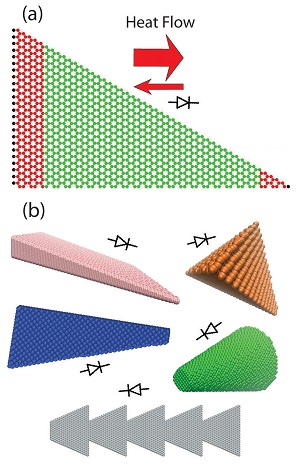CLOUD
Research could bring new devices that control heat flow

Researchers are proposing a new technology that might control the flow of heat the way electronic devices control electrical current, an advance that could have applications in a diverse range of fields from electronics to textiles.
The concept uses tiny triangular structures to control "phonons," quantum-mechanical phenomena that describe how vibrations travel through a material's crystal structure.
Findings in research using advanced simulations show the triangular or T-shaped structures - if small enough in width - are capable of "thermal rectification," or permitting a greater flow of heat in one direction than in the opposite direction, said Xiulin Ruan, an associate professor in Purdue University's School of Mechanical Engineering and Birck Nanotechnology Center.
Rectification has made possible transistors, diodes and memory circuits central to the semiconductor industry. The new devices are thermal rectifiers that might perform the same function, but with phonons instead of electrical current.
"In most systems, heat flow is equal in both directions, so there are no thermal devices like electrical diodes. However, if we are able to control heat flow like we control electricity using diodes then we can enable a lot of new and exciting thermal devices including thermal switches, thermal transistors, logic gates and memory," said Ruan, whose research group collaborated with a group led by Yong Chen, an associate professor in Purdue's Department of Physics and School of Electrical and Computer Engineering. "People are just starting to understand how it works, and it is quite far from being used in applications."
Findings are detailed in a research paper that has appeared online in the journal Nano Letters and will be published in an upcoming issue of the journal. The paper was authored by doctoral students Yan Wang, Ajit Vallabhaneni and Jiuning Hu and former doctoral student Bo Qiu; Chen; and Ruan.
The researchers used an advanced simulation method called molecular dynamics to demonstrate thermal rectification in structures called "asymmetric graphene nanoribbons." Molecular dynamics simulations can simulate the vibrations of atoms and predict the heat flow in a material.
Graphene, an extremely thin layer of carbon, is promising for applications in electronics and computers. The triangular structure must be tiny in width to make possible the "lateral confinement" of phonons needed for the effect. Findings also show thermal rectification is not limited to graphene but could be seen in other materials in structures such as pyramidal, trapezoidal or T-shaped designs.
Hu, Ruan, and Chen also published a paper four years ago in the journal Nano Letters, among the first to propose asymmetric graphene nanoribbons as a thermal rectifier in research using the molecular dynamics simulations. Although numerous studies have been devoted to this topic since then, until now researchers did not know the mechanism behind thermal rectification. The new findings show that this mechanism works by restricting vibrations as they travel through the small lateral direction of an asymmetrical structure.
"We demonstrate that other asymmetric materials, such as asymmetric nanowires, thin films, and quantum dots of a single material can also be high-performance thermal rectifiers, as long as you have lateral confinement," Ruan said. "This really broadens the potential of this rectification to a much wider spectrum of applications."
Thermal rectification is not seen in larger triangular-shape structures because they lack lateral confinement. In order for lateral confinement to be produced, the cross section of the structure must be much smaller than the "mean free path" of a phonon, or only a few to hundreds of nanometers depending on the material, Wang said.
"This is the average distance a phonon can travel before it collides with another phonon," he said.
However, although the devices must be tiny, they could be linked in series to produce larger structures and better rectification performance.
The concept could find uses in "thermal management" applications for computers and electronics, buildings and even clothing.
"For example, on a winter night you don't want a building to lose heat quickly to the outside, while during the day you want the building to be warmed up by the sun, so it would be good to have building materials that permit the flow of heat in one direction, but not the other," Ruan said.
A potential, although speculative, future application could be thermal transistors. Unlike conventional transistors, thermal transistors would not require the use of silicon, are based on phonons rather than electrons and might make use of the large amount of waste heat that is already generated in most practical electronics, said Chen.
The research was funded by the U.S. Air Force Office of Scientific Research.
